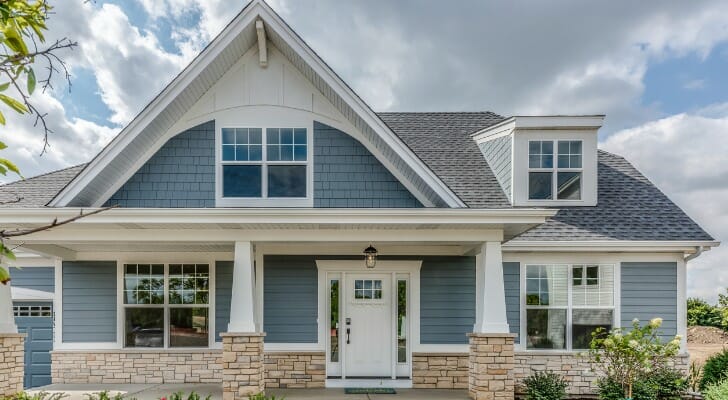Potential home buyers have a lot of research to do before they purchase a home. Part of that research involves finding the right type of loan to pay for your future residence with. There are multiple types of mortgages out there, and each one is unique. Where one might offer more competitive interest rates, others might have more lenient eligibility requirements. They all have their drawbacks as well, and the wrong one can cost you more than necessary. Consider working with a financial advisor as you decide how to finance your purchase in the context of your larger financial plan.
Fixed-Rate Mortgages
Mortgages come in two main types: fixed-rate and adjustable-rate. Fixed-rate mortgages maintain one interest rate and, thus, one payment amount for the loan’s entire life. These loans typically come with either a 15-year term or a 30-year term. However, some lenders allow their borrowers to negotiate a term between 8 to 30 years.
So, if you want a predictable monthly repayment, a fixed-rate mortgage is your best bet. Since the interest rate doesn’t change, neither will the amount due. That makes calculating and sticking to a budget much easier for most borrowers. That consistency makes them suitable for people who plan to stay in their home for a long time as well.
On the other hand, though, fixed-rate loans may require more interest over the long-term. That’s partially due to the higher rates found with fixed-rates compared to adjustable-rate loans.
Adjustable-Rate Mortgages (ARMs)
If you don’t want a fixed-rate, then you’re looking at an adjustable-rate mortgage (ARM). An ARM’s interest fluctuates according to market conditions. It only begins to change after the first few years of the loan, though. For instance, you may apply for a 5/1 ARM, meaning your rate stays the same for the first five years and then adjusts once a year after that. ARMs typically also come in 3/1, 7/1 and 10/1 variations.
An adjustable-rate loan may work better for borrowers who don’t plan to stay in their home very long. That’s because the initial fixed rate on an ARM is typically lower than the rate offered with a fixed rate. So, you can save a significant amount on interest during repayment.
However, ARMs can be become more expensive over time, which may lead to default. Plus, you may miss out on the opportunity to easily refinance or sell at your lower rate if the home’s value drops. Overall, they’re risky but potentially beneficial if you own the property short-term.
Conventional Loans
Conventional loans are mortgages that the federal government does not back. They break down into two categories: conforming and non-conforming.
Conforming loans have to follow Fannie Mae’s and Freddie Mac’s lending rules. That allows the lender to sell the loan to said mortgage companies, which then sell them to investors. In comparison, non-conforming loans don’t have to meet those standards. They usually either help borrowers finance an expensive home or purchase a house with subpar credit.
According to Census data, conventional loans are the most common type of mortgage borrowed in the U.S. Their borrowing costs are usually lower, even with higher interest rates, and they can be used for various types of properties. However, borrowers usually need to be strong candidates, i.e., high credit score, DTI ratio below 43% and proof of assets.
Because of this, conventional loans are best suited for financially stable individuals with good credit scores and a substantially sized down payment ready. This will allow them to borrow with better terms and avoid private mortgage insurance (PMI).
USDA Loans
The United States Department of Agriculture insures USDA loans, which are designed to help borrowers in rural areas with moderate to low income. You can use the USDA’s eligibility map on its website to find out whether a property is in an eligible area. On top of that, the borrower must meet specific income limits to qualify.
In many cases, the USDA does not require a down payment. There are also grants and home improvement loans available to borrowers. However, there are additional fees, like an upfront fee worth 1% of the loan amount as well as an annual fee.
USDA loans work well for income-qualified home buyers in rural (or some suburban) areas who need a low or zero down payment.
FHA Loans
FHA mortgages are insured by the Federal Housing Administration. They help buyers with weaker financial profiles purchase a home. Requirements can be as flexible as a minimum down payment of 3.5% and a qualifying credit score of 500.
However, FHA loans require borrowers to pay mortgage insurance premiums. You pay one premium upfront, whereas you pay the other annually over the loan’s life if you have a down payment smaller than 10%.
You’ll likely benefit from an FHA loan if you can only pay a down payment less than 20% or if you have a lackluster credit score.
VA Loans

VA loans are designed for current or former members of the U.S. military and their families. These loans come with flexible requirements and a wide range of perks. For example, they don’t require a down payment, but they also don’t require mortgage insurance. They also cap closing costs and usually charge a competitively low-interest rate.
There is a VA funding fee, though. This is a percentage of the loan’s total amount, and it helps offset the program’s cost for taxpayers. But it can be rolled into the loan along with other closing costs.
Because of the eligibility requirements, VA loans are best for military-qualified borrowers who want a primary home.
Jumbo Loans
Jumbo loans are non-conforming loans, which means they exceed the loan limits set by Fannie Mae and Freddie Mac. These loan limits typically change annually and vary from county to county depending on the home market in that area. For 2022, the base jumbo loan limit is $647,200, while the highest cost areas in the U.S. will have a limit up to $970,800.
A jumbo loan will generally carry a higher interest rate than their conforming counterparts. However, this varies widely between lenders. That’s because jumbo loan lenders have more control over the requirements their borrowers need to meet.
While criteria vary, jumbo loans can be a risk for their lenders. As a result, the best borrower typically needs excellent credit and in-depth proof of their assets or income. They also need a down payment of at least 10% to 20%.
Ultimately, a jumbo loan may be your best option if you want to purchase an expensive property.
Less Common Mortgage Types to Know
The above are some of the most common types of mortgages. However, you can find other options when shopping for a loan, such as:
Piggyback Loans
A piggyback loan actually involves more than one loan. It also often goes by an alternative name: 80/10/10 loan.
The first loan is valued at 80% of the home’s price. Then the second loan equals 10% of the price. Finally, you make a down payment of 10% – thus, 80/10/10.
These loans can help borrowers avoid the additional cost of mortgage insurance. However, while you are trading in your private mortgage insurance (PMI) costs, you have others to deal with. Since there are two loans involved, you must also pay closing costs for both. You’re also responsible for the interest each loan accrues. Because of this, borrowers should run some example calculations to see if they save money through this option.
Interest-Only Loans
An interest-only loan requires you to solely pay the loan’s interest for a predetermined period. Once that period passes (typically five to seven years), your monthly repayment includes some funds for the principal as well. That means that your payment amount increases.
One of the disadvantages of an interest-only loan is that you don’t build equity quickly. However, they can be a good option for those who know they will refinance or sell later. It also can work for those who can easily accommodate the higher monthly payments down the road.
Construction Loans
A construction loan is a go-to choice for borrowers building a home. In some cases, the borrower gets a construction loan to cover the project and then a separate mortgage to pay those costs off. Alternatively, they may wrap the two loans together as a construction-to-permanent loan.
Construction loans typically require higher down payments and come with higher interest rates. That results in higher monthly payments. Lenders will also put emphasis on the borrower providing proof that they can afford it.
They have their advantages, though: multiple types makes it easy to find the right financings, you only have to pay interest during construction, you can transition to a permanent loan, and they have flexible terms.
Balloon Loans
When you borrow a balloon loan, you must make a large payment at the end of the loan’s term. Usually, you’ll make your payments according to a 30-year term. However, that’s only for a certain amount of time.
Once that period ends, you’ll make a single payment to cover the outstanding balance. Because of this structure, balloon mortgages can financially overwhelm you if you don’t prepare beforehand.
Which Mortgage Type Is Best for You?
In the end, the right mortgage will depend on several factors. You’ll want to consider things like:
- Your financial situation
- How much you can afford long-term
- How much you can save for upfront costs
- The length of the loan
- The typical interest rate of the loan type
- What type of candidate you are (i.e., if you have a military connection, have a low credit score, etc.)
Still, figuring out the right mortgage may take some time. Break down your situation and compare it to your available options to see which one fits your needs.
For instance, let’s say you have qualifying military experience in your background. However, you want to purchase a property as an investment. The only way to use a VA loan for an investment is to buy a multi-unit property and live there long enough to meet the VA’s occupancy rules. During that time, you can rent out the other units.
But if that isn’t the type of investment you want, you may have to look at other loans like a conventional loan.
Or, say you are someone working with a strict budget. You don’t see your income increasing in the near future, either. In that case, you likely want to avoid interest-only loans and ARMs since their monthly repayments increase over time.
Like this, you can narrow down your options by matching them to your situation.
Bottom Line

Everyone’s situation is different; that means there is no one-size-fits-all loan. Instead, you need to consider your goals, your financial capabilities and more to find the right one. After you find the right loan, your next step is to choose the best lender. Like mortgages, every lender is different, and it’s crucial to shop around for the most suitable choice. Options vary from brick-and-mortar banks to credit unions to online lenders, so take your time researching.
Tips to Save for a Home
- Finding a home loan that fits into your overall financial plan can be overwhelming. If you need support during the process, consider working with a financial advisor. Finding a qualified financial advisor doesn’t have to be hard. SmartAsset’s free tool matches you with up to three financial advisors who serve your area, and you can interview your advisor matches at no cost to decide which one is right for you. If you’re ready to find an advisor who can help you achieve your financial goals, get started now.
- If you’re looking to get a mortgage, understanding the current state of the rate environment is imperative. SmartAsset’s mortgage rates page can help you do so.
Photo credit: ©iStock.com/fizkes, ©iStock.com/designer491, ©iStock.com/PC Photography
